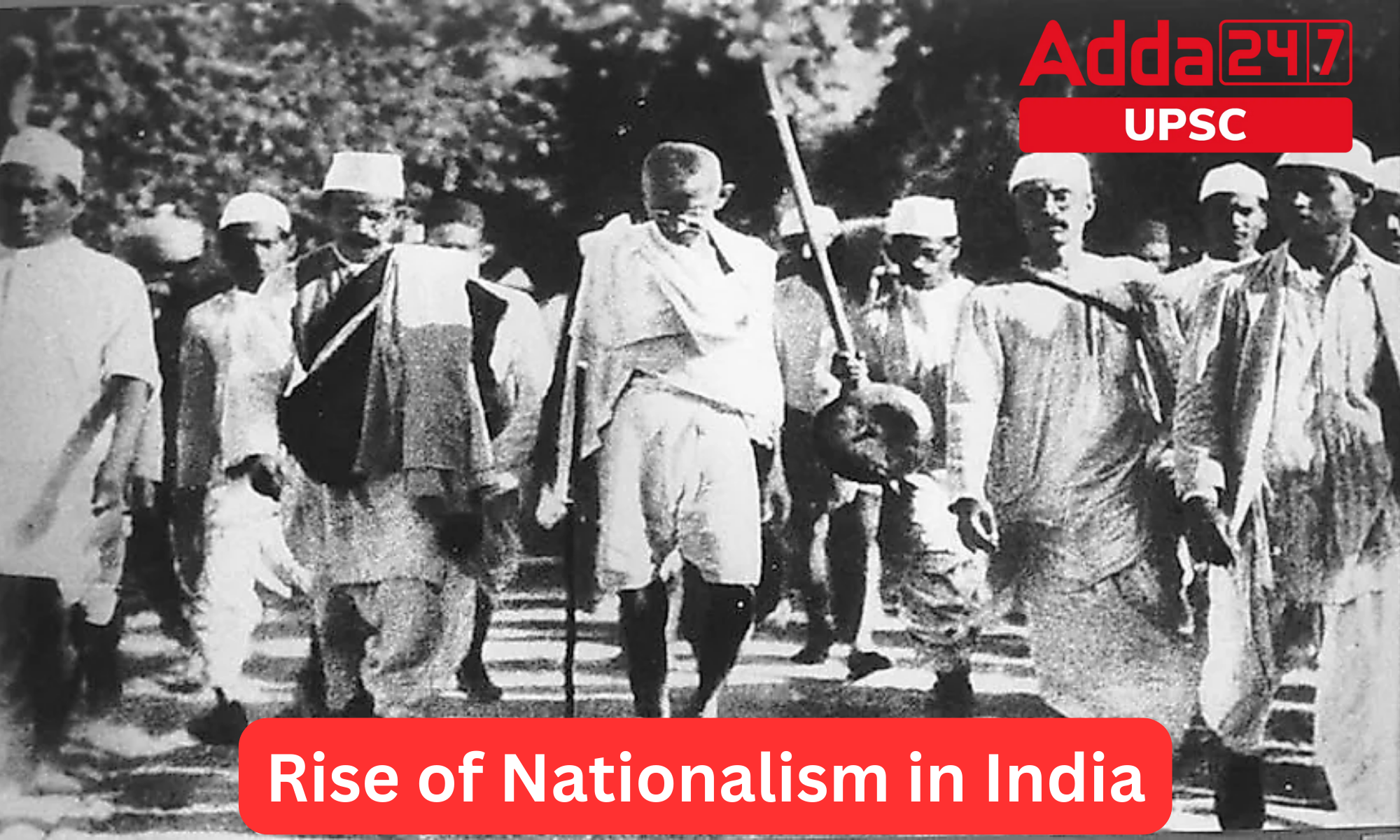Table of Contents
Rise of Nationalism in India
The rise of nationalism in India has been a long and complex journey. It is a movement that has had a profound impact on the country’s history, politics, and society. From the early 20th century, India has been home to a diverse range of nationalist movements, each with their own unique set of goals and ideologies. In this article, we will examine the various factors that have contributed to the rise of nationalism in India and the impact it has had on the country.
Rise of Nationalism in India: What is Nationalism?
Nationalism is a complex and multifaceted concept that has shaped human history and politics for centuries. It can be defined as a strong sense of loyalty and devotion to one’s nation or country, often characterized by a shared culture, language, religion, and history. Nationalism is often associated with a desire for self-determination, sovereignty, and independence.
- Nationalism can manifest in various forms, from cultural and linguistic preservation to political and economic independence.
- It can be a unifying force, bringing people together around shared values and goals, or it can be a divisive force, pitting different groups against each other in the pursuit of their own interests.
- One of the key drivers of nationalism is a sense of identity and belonging.
- People often identify with their nation or country and feel a sense of pride and loyalty towards it.
- This identity is shaped by a range of factors, including history, language, culture, religion, and political institutions.
- Nationalism can be a positive force for change, as it can mobilize people to work towards common goals and values.
- For example, it played a critical role in the fight for independence in many countries, including the United States, India, and South Africa.
- It can also be a powerful tool for social and economic development, as it encourages people to invest in their communities and work towards shared prosperity.
- However, nationalism can also be a negative force, leading to conflict and violence.
- Nationalist movements often prioritize the interests of their own group over those of others, which can lead to discrimination and even violence against minority groups.
- This can be seen in the rise of ethnic nationalism in Europe, which has fueled xenophobia and anti-immigrant sentiment.
- Nationalism can also be used to justify aggressive and expansionist policies, as seen in the rise of imperialistic powers in the 19th and 20th centuries.
- This has often led to war and conflict, as competing nationalist interests collide.
- Moreover, the rise of nationalist movements has been associated with the decline of internationalism and global cooperation.
- This can be seen in the recent rise of populism and anti-globalization movements in many parts of the world.
- These movements reject the idea of global governance and cooperation, instead promoting a narrow and exclusionary vision of national identity.
Nationalism is a powerful and complex force that has shaped human history and politics for centuries. It can be a unifying force, bringing people together around shared values and goals, or it can be a divisive force, pitting different groups against each other in the pursuit of their own interests. While nationalism can be a positive force for change, it can also be a negative force, leading to conflict and violence. As such, it is important to recognize the role of nationalism in our world and to work towards a vision of national identity that is inclusive, respectful, and cooperative.
Rise of Nationalism in India: Historical Background
- The history of nationalism in India can be traced back to the late 19th century, when the Indian National Congress (INC) was established.
- The INC was founded in 1885 by A.O. Hume, a retired British civil servant, and a group of Indian leaders.
- Its main goal was to promote Indian interests within the British Empire and achieve self-rule for India.
- In the early years, the INC was a moderate organization that focused on constitutional reforms and gradual political change.
- However, the early 20th century saw the rise of more radical forms of nationalism in India. The partition of Bengal in 1905 was a turning point in Indian politics.
- The decision to divide Bengal along religious lines was seen as a deliberate attempt by the British to weaken the growing nationalist movement in the region.
- This sparked widespread protests and boycotts, and marked the beginning of a more militant phase of the nationalist movement.
The 1919 Amritsar massacre (Jallianwala Bagh Massacre), in which British troops opened fire on a crowd of peaceful protesters, further fueled nationalist sentiment. The incident was a turning point in Indian history and marked the beginning of the end of British rule in India.

Factors Contributing to the Rise of Nationalism in India
There were several factors that contributed to the rise of nationalism in India. Following are some of the most important factors that contributed to the rise of nationalism in India:
Factors Contributing to the Rise of Nationalism in India: Growth of New class
One of the most important was the growth of a middle class in the country. The emergence of a new class of educated, urban Indians who were exposed to Western ideas and values played a key role in the growth of nationalism. These individuals were often employed in the civil service or other professions, and they were keen to assert their rights and claim a greater role in the governance of the country.
Factors Contributing to the Rise of Nationalism in India: Impact of World War I
Another important factor was the impact of World War I. The war had a profound impact on India, both in terms of the economy and politics. The Indian economy suffered greatly as a result of the war, and many Indians were forced to serve in the British army. The war also had a profound impact on Indian political consciousness, as many Indians began to question the legitimacy of British rule.
Factors Contributing to the Rise of Nationalism in India: Growth of the Indian press
The growth of the Indian press was another important factor in the rise of nationalism. Newspapers and magazines played a crucial role in disseminating nationalist ideas and promoting political awareness. Many of the leading nationalist figures of the time were also journalists and editors.

Impact of Rise of Nationalism in India
The rise of nationalism in India had a profound impact on the country. It led to the end of British rule in India and the establishment of an independent Indian state in 1947. The nationalist movement also played a key role in shaping the country’s political landscape, as many of the leading figures in Indian politics were also nationalist leaders.
The nationalist movement also had a significant impact on Indian society. It played a key role in promoting social reform and raising awareness about issues such as caste discrimination and gender inequality. Many of the leading nationalist figures were also social reformers who campaigned for the rights of marginalized communities.
The legacy of the nationalist movement can still be seen in modern India. The country’s political system is based on the principles of democracy and secularism, which were championed by the nationalist movement. The movement also laid the groundwork for many of the social and economic reforms that have taken place in the country in recent years.
The Rise of Nationalism in Contemporary India
While the nationalist movement in India played a key role in shaping the country’s history, politics, and society, it did not end with the achievement of independence in 1947. In fact, nationalism remains a potent force in contemporary India, and has continued to evolve and change over time.
- One of the most significant developments in recent years has been the rise of Hindu nationalism.
- Hindu nationalism is an ideology that seeks to promote the interests of Hindus in India and has gained significant political and social traction in recent years.
- The Bharatiya Janata Party (BJP), which is the ruling party in India, is closely associated with Hindu nationalism and has been accused of promoting a Hindu-centric agenda.
- The rise of Hindu nationalism has had a significant impact on Indian politics and society.
- It has led to increased polarization and divisiveness, as well as tensions between different religious and ethnic communities.
- There have been several instances of communal violence and discrimination against minority communities, particularly Muslims.
- The rise of Hindu nationalism has also been accompanied by a resurgence of cultural nationalism.
- Cultural nationalism is an ideology that emphasizes the importance of preserving Indian culture and traditions, and has been used by some to promote a narrow and exclusionary version of Indian identity.
- This has led to increased tensions between different regions and communities within India.
- At the same time, there have also been voices of dissent against the growing tide of nationalism in India.
- Many civil society groups, intellectuals, and activists have spoken out against the divisive and exclusionary nature of some forms of nationalism, and have called for a more inclusive and tolerant vision of India.
Rise of Nationalism in India: Overall Process
The rise of nationalism in India has been a complex and multifaceted process. From the early 20th century to the present day, India has been home to a diverse range of nationalist movements, each with their own unique set of goals and ideologies.
While the nationalist movement in India played a key role in achieving independence from British rule and shaping the country’s history and politics, it has also had its share of challenges and controversies. The rise of Hindu nationalism and cultural nationalism in recent years has led to increased polarization and tensions between different communities.
Ultimately, the future of nationalism in India will depend on how the country’s leaders and citizens choose to navigate these challenges. It is up to all of us to work towards building a more inclusive, tolerant, and democratic society that celebrates the diversity and richness of Indian culture and heritage.
| Also Read: | |



 TSPSC Group 1 Question Paper 2024, Downl...
TSPSC Group 1 Question Paper 2024, Downl...
 TSPSC Group 1 Answer key 2024 Out, Downl...
TSPSC Group 1 Answer key 2024 Out, Downl...
 UPSC Prelims 2024 Question Paper, Downlo...
UPSC Prelims 2024 Question Paper, Downlo...





